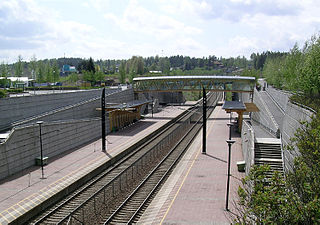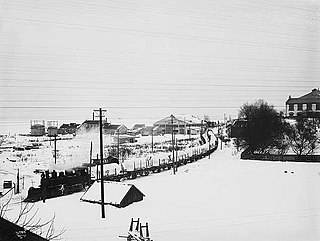
The Norwegian railway system comprises 4,109 km of 1,435 mm track of which 2,644 km is electrified and 274 km double track. There are 697 tunnels and 2,760 bridges.

Vygruppen, branded as Vy, formerly the Norwegian State Railways, branded as NSB, is a government-owned railway company which operates most passenger train services and many bus services in Norway. The company is owned by the Norwegian Ministry of Transport. Its sub-brands include Vy Buss coach services, CargoNet freight trains and the Swedish train transport company Tågkompaniet. In 2009, NSB carried 52 million train passengers and 104 million bus passengers. On 24 April 2019, passenger train and bus services were rebranded as Vy.
Linx AB was a railway company which operated inter-Scandinavian passenger trains between 2001 and 2004. Established as a joint venture between the Norwegian State Railways (NSB) and the Swedish state-owned SJ, Linx operated the routes from Oslo, Norway, to Stockholm, Sweden, and from Oslo via Gothenburg, Sweden, to Copenhagen, Denmark. Services were provided up to ten times per day. However, slow speeds caused by curvy infrastructure in Norway, combined with competition from low-cost airlines, caused the company to lose money, and eventually grounded operations. The services were taken over by NSB and SJ. The main rolling stock were eleven X2 electric multiple units, although it used SJ Rc-hauled trains on the Gothenburg–Oslo service. The company was based in Gothenburg.

The Gardermoen Line is a high-speed railway line between Oslo and Eidsvoll, Norway, running past Lillestrøm and Oslo Airport, Gardermoen. The line is 64 kilometres (40 mi) long and replaced the older Hoved Line as the main line north-east of Oslo. The older Hoved Line now handles commuter and freight traffic, while the Gardermoen Line handles high-speed passenger trains and freight trains laden with jet fuel for the airport. Both lines are owned by Bane NOR.

NSB El 18 is a class of 22 electric locomotives built by Adtranz and Swiss Locomotive & Machine Works (SLM) for the Norwegian State Railways (NSB). The class is a modification of the Swiss Federal Railways Re 460 locomotive and built at Adtranz Strømmen in 1996 and 1997. The class remains the only mainline electric locomotive used by NSB, and is predominantly used on some intercity services and all night trains on the Bergen Line, Dovre Line and Sørland Line, as well as some regional trains.

CargoNet AS is the primary operator of freight trains on the Norwegian railway system.

Vy Gjøvikbanen AS is a Norwegian railway company that operates the passenger train service on the Gjøvik Line. A subsidiary of the state-owned Vy, it operates a fleet of nine Class 69g three-car electric multiple units. NSB Gjøvikbanen provides two different services: the Skøyen – Oslo S – Jaren service is part of the Oslo Commuter Rail; while Oslo S – Gjøvik is a regional service, with only limited stops on the route until Grua. Departures are each 40 minutes, with every third train running to Gjøvik.

The Trøndelag Commuter Rail is a commuter train service operating in Trøndelag county, Norway. It was operated by Vy with Class 92 diesel multiple units, until 7 June 2020 when SJ Norge took over the contract until 2030. The service provides a commuter service connecting Trondheim to its suburbs, between towns in Innherred and as an airport rail link for Trondheim Airport, Værnes. Although passenger services have operated along the lines since 1864, the commuter train was created with an increase of service with existing rolling stock in 1993. In 2019, the system was used by 1.4 million passengers.
The Norwegian National Rail Administration was a government agency responsible for owning, maintaining, operating and developing the Norwegian railway network, including the track, stations, classification yards, traffic management and timetables. Safety oversight was the duty of the Norwegian Railway Inspectorate, while numerous operating companies run trains on the lines; the largest being the state owned passenger company Vy and the freight company CargoNet.
Ofotbanen Drift AS, trading as Ofotbanen, was a Norwegian passenger and freight railway company. The company operated a fleet of six locomotives, three multiple units, 22 passenger and 48 freight cars. The sole service was the passenger train Unionsexpressen between Oslo and Stockholm; it had previously offered freight haulage on contract.

The Holmestrand–Hvittingfoss Line or HVB is an abandoned railway between Holmestrand to Hvittingfoss in Norway. It consisted of two sections: a 13.4-kilometer (8.3 mi) line from Holmestrand to Hillestad and a 10.4-kilometer (6.5 mi) section from Hof to Hvittingfoss. The two parts were connected by a 6 kilometers (4 mi) section of the Tønsberg–Eidsfoss Line. At Holmestrand Station, the line connected to the Vestfold Line of the Norwegian State Railways. HVB was opened on 30 September 1902 and closed on 1 June 1938. The main purpose of the line was the transport of wood pulp at Hvittingfoss, although it was also used for passenger transport until 1931.

The Tønsberg–Eidsfoss Line or TEB is an abandoned railway between Eidsfoss and Tønsberg in Vestfold og Telemark county, Norway. In use from 21 October 1901 to 31 May 1938, the private railway connected the area of Hof to Tønsberg, the coast and the Vestfold Line of the Norwegian State Railways. The main purpose of the 48.10-kilometre (29.89 mi) narrow gauge railway was to connect Eidsfos Verk to the mainline, although the railway also operated passenger trains. The line shares 6 kilometres (3.7 mi) with the Holmestrand–Vittingfoss Line (HVB), the two which from 1934 were operated by the same company, Vestfold Privatbaner.

Ruter AS is the public transport authority for Oslo and Akershus counties in Norway. Formally a limited company – 60% of its shares are owned by the Oslo county municipality and 40% by that of Akershus – it is responsible for the administration, funding, and marketing of public transport in the two counties, including buses, the Oslo Metro, Oslo Trams, and ferry services. Ruter also holds agreements with Entur concerning the regulation of fares on local and regional train services operated within the two counties.
Strømmens Værksted A/S was an industrial company based in Skedsmo, Norway, specialising in the production of rolling stock. Founded in 1873, it remains as a part of Bombardier Transportation. The plant is located just off Hovedbanen west of Strømmen Station.
Norsk Elektrisk & Brown Boveri A/S also known as NEBB was a Norwegian manufacturing company, which built a lot of the rolling stock that is used by Norges Statsbaner. The plant was located at Skøyen. In 1988 it merged into Asea Brown Boveri (ABB).

The Norwegian Union of Railway Workers is a trade union in Norway. It was formed on 20 November 1892, and mainly organizes workers in Norges Statsbaner—with the exception of locomotive drivers— and the Norwegian National Rail Administration, including related companies such as BaneTele, Nettbuss, Nettlast, Malmtrafik, MiTrans, Mantena, Trafikkservice, CargoNet, Baneservice, Arrive, Ofotbanen AS, NSB Gjøvikbanen and Flytoget.
Hønefoss Jernbanevogn- og Karosserifabrikk A/S, trading as Høka and at first known as Hønefoss Karosserifabrikk A/S, was a manufacturer of bodywork for buses, trucks and trains. The company was in existence from 1936 to 1968 and was based in Hønefoss, Norway. Among the company's products is Oslo Tramway's SM53 trams, the Trondheim Tramway's GB Class 3 tram and the Norwegian State Railways Skd 221 shunters.

Private railways in Norway consist of industrial and public railways. Industrial railways were used to transport ore or other industrial products to ports, although they have, particularly to begin with, also operated passenger and cargo services. The other nine private railways have been public and operated as mixed passenger and freight services. Of these, four were later taken over by the Norwegian State Railways (NSB). Only five non-industrial railways were never nationalized, despite all having been closed. There were the Nesttun–Os, Holmestrand–Vittingfoss, Lillesand–Flaksvand, Tønsberg–Eidsfoss and the Lier lines. No industrial railways remain in operation, although one former private railway, the Trunk Line, Norway's first railway, is still in use.

The Norwegian State Railways was a state-owned railway company that operated most of the railway network in Norway. The government agency/directorate was created in 1883 to oversee the construction and operation of all state-owned railways in Norway. On 1 December 1996, it was demerged to create the infrastructure operator Norwegian National Rail Administration, the train operator Norwegian State Railways and the Norwegian Railway Inspectorate. The name was taken by the train operator, although the infrastructure operator remained a government agency and is the legal successor.
Vestfold Privatbaner was a private railway company which operated two railways in Vestfold, Norway, the Holmestrand–Vittingfoss Line (HVB) and the Tønsberg–Eidsfoss Line (TEB). The company was created in 1934 as a merger between the two former operating companies of each of the two lines, but Vestfold Privatbaner closed operations already on 1 June 1938.













